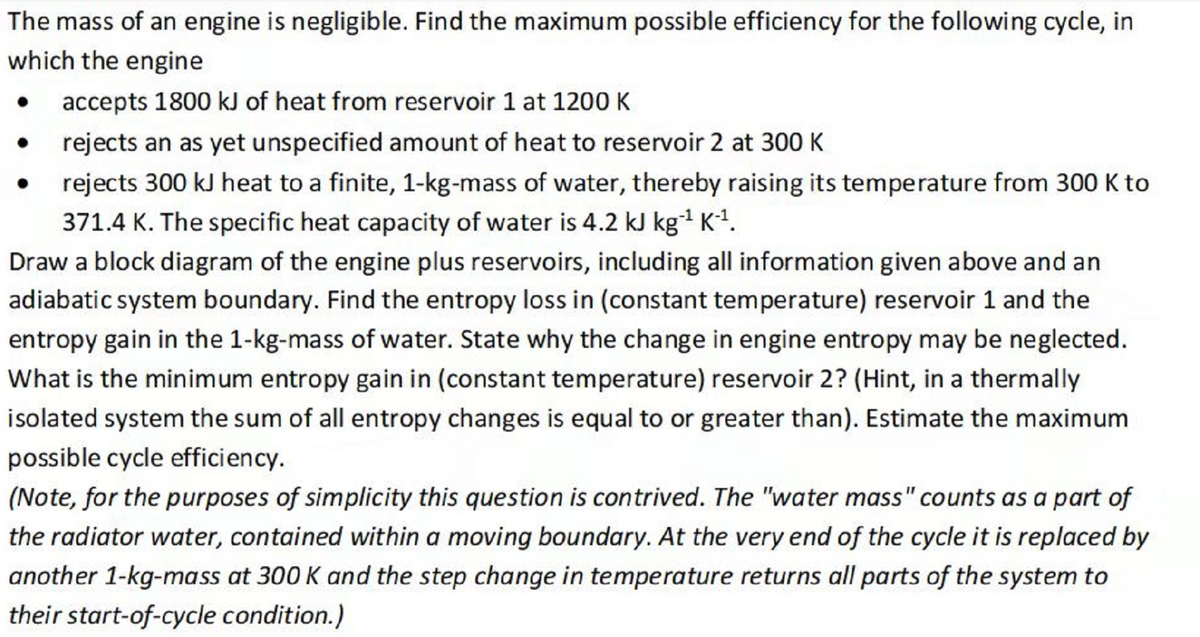The mass of an engine is negligible. Find the maximum possible efficiency for the following cycle, in which the engine accepts 1800 kJ of heat from reservoir 1 at 1200 K rejects an as yet unspecified amount of heat to reservoir 2 at 300 K ● rejects 300 kJ heat to a finite, 1-kg-mass of water, thereby raising its temperature from 300 K to 371.4 K. The specific heat capacity of water is 4.2 kJ kg-¹ K-¹. Draw a block diagram of the engine plus reservoirs, including all information given above and an adiabatic system boundary. Find the entropy loss in (constant temperature) reservoir 1 and the entropy gain in the 1-kg-mass of water. State why the change in engine entropy may be neglected. What is the minimum entropy gain in (constant temperature) reservoir 2? (Hint, in a thermally isolated system the sum of all entropy changes is equal to or greater than). Estimate the maximum possible cycle efficiency. (Note, for the purposes of simplicity this question is contrived. The "water mass" counts as a part of the radiator water, contained within a moving boundary. At the very end of the cycle it is replaced by another 1-kg-mass at 300 K and the step change in temperature returns all parts of the system to their start-of-cycle condition.)
The mass of an engine is negligible. Find the maximum possible efficiency for the following cycle, in which the engine accepts 1800 kJ of heat from reservoir 1 at 1200 K rejects an as yet unspecified amount of heat to reservoir 2 at 300 K ● rejects 300 kJ heat to a finite, 1-kg-mass of water, thereby raising its temperature from 300 K to 371.4 K. The specific heat capacity of water is 4.2 kJ kg-¹ K-¹. Draw a block diagram of the engine plus reservoirs, including all information given above and an adiabatic system boundary. Find the entropy loss in (constant temperature) reservoir 1 and the entropy gain in the 1-kg-mass of water. State why the change in engine entropy may be neglected. What is the minimum entropy gain in (constant temperature) reservoir 2? (Hint, in a thermally isolated system the sum of all entropy changes is equal to or greater than). Estimate the maximum possible cycle efficiency. (Note, for the purposes of simplicity this question is contrived. The "water mass" counts as a part of the radiator water, contained within a moving boundary. At the very end of the cycle it is replaced by another 1-kg-mass at 300 K and the step change in temperature returns all parts of the system to their start-of-cycle condition.)
Elements Of Electromagnetics
7th Edition
ISBN:9780190698614
Author:Sadiku, Matthew N. O.
Publisher:Sadiku, Matthew N. O.
ChapterMA: Math Assessment
Section: Chapter Questions
Problem 1.1MA
Related questions
Question

Transcribed Image Text:The mass of an engine is negligible. Find the maximum possible efficiency for the following cycle, in
which the engine
accepts 1800 kJ of heat from reservoir 1 at 1200 K
rejects an as yet unspecified amount of heat to reservoir 2 at 300 K
●
rejects 300 kJ heat to a finite, 1-kg-mass of water, thereby raising its temperature from 300 K to
371.4 K. The specific heat capacity of water is 4.2 kJ kg-¹ K-¹.
Draw a block diagram of the engine plus reservoirs, including all information given above and an
adiabatic system boundary. Find the entropy loss in (constant temperature) reservoir 1 and the
entropy gain in the 1-kg-mass of water. State why the change in engine entropy may be neglected.
What is the minimum entropy gain in (constant temperature) reservoir 2? (Hint, in a thermally
isolated system the sum of all entropy changes is equal to or greater than). Estimate the maximum
possible cycle efficiency.
(Note, for the purposes of simplicity this question is contrived. The "water mass" counts as a part of
the radiator water, contained within a moving boundary. At the very end of the cycle it is replaced by
another 1-kg-mass at 300 K and the step change in temperature returns all parts of the system to
their start-of-cycle condition.)
Expert Solution
This question has been solved!
Explore an expertly crafted, step-by-step solution for a thorough understanding of key concepts.
Step by step
Solved in 2 steps with 2 images

Knowledge Booster
Learn more about
Need a deep-dive on the concept behind this application? Look no further. Learn more about this topic, mechanical-engineering and related others by exploring similar questions and additional content below.Recommended textbooks for you

Elements Of Electromagnetics
Mechanical Engineering
ISBN:
9780190698614
Author:
Sadiku, Matthew N. O.
Publisher:
Oxford University Press

Mechanics of Materials (10th Edition)
Mechanical Engineering
ISBN:
9780134319650
Author:
Russell C. Hibbeler
Publisher:
PEARSON

Thermodynamics: An Engineering Approach
Mechanical Engineering
ISBN:
9781259822674
Author:
Yunus A. Cengel Dr., Michael A. Boles
Publisher:
McGraw-Hill Education

Elements Of Electromagnetics
Mechanical Engineering
ISBN:
9780190698614
Author:
Sadiku, Matthew N. O.
Publisher:
Oxford University Press

Mechanics of Materials (10th Edition)
Mechanical Engineering
ISBN:
9780134319650
Author:
Russell C. Hibbeler
Publisher:
PEARSON

Thermodynamics: An Engineering Approach
Mechanical Engineering
ISBN:
9781259822674
Author:
Yunus A. Cengel Dr., Michael A. Boles
Publisher:
McGraw-Hill Education

Control Systems Engineering
Mechanical Engineering
ISBN:
9781118170519
Author:
Norman S. Nise
Publisher:
WILEY

Mechanics of Materials (MindTap Course List)
Mechanical Engineering
ISBN:
9781337093347
Author:
Barry J. Goodno, James M. Gere
Publisher:
Cengage Learning

Engineering Mechanics: Statics
Mechanical Engineering
ISBN:
9781118807330
Author:
James L. Meriam, L. G. Kraige, J. N. Bolton
Publisher:
WILEY